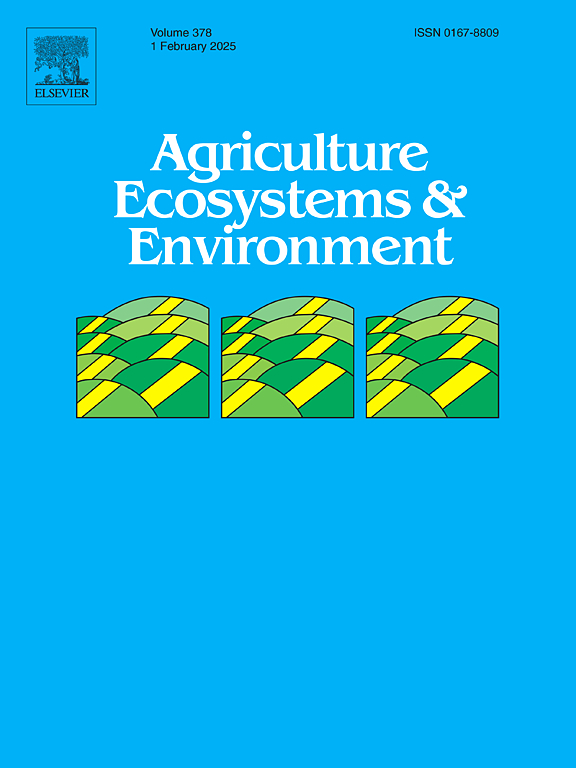蚯蚓介导不同作物轮作对土壤有机碳吸收、土壤结构形成和微生物活动的影响
IF 6
1区 农林科学
Q1 AGRICULTURE, MULTIDISCIPLINARY
引用次数: 0
摘要
作物轮作多样化旨在提高土壤肥力和生产力。由于蚯蚓对土壤有机质动态、养分循环和土壤结构的影响,在许多耕作系统中,蚯蚓为帮助实现这一目标提供了巨大的希望。我们评估了不同作物轮作对蚯蚓对土壤有机碳吸收、结构形成和微生物活动调节的影响。采用15 d的微生物群落试验,每个微生物群落中有5只斑背蝽和20 g不同作物秸秆组合,分别代表潘帕斯草原常见的作物轮作方案:无秸秆(NR)、大豆(S)、大豆+玉米(SM)和黄豆+玉米+大豆(VMS)。A. caliginosa在VMS中产生的粗颗粒有机碳比散装土壤多36 %和25 % (p <; 0.0001),而在SM中产生的粗颗粒有机碳比散装土壤多100-165 % (p <; 0.0001)。SM处理的细颗粒物有机碳含量比其他处理高23 ~ 42 %,比散装土高42 % (p = 0.0002)。此外,与S和NR相比,VMS和SM的铸件平均重量直径高出35-70 % (p <; 0.0001),水稳性蚯蚓大团聚体比例高出30-1400 % (BMa: p <; 0.0001;SMa: p = 0.0235)。投在vm高α葡糖苷酶(39 %)(p & lt; 0.0001),β葡糖苷酶(220 %)(p & lt; 0.0001),磷酸单酯酶(48 %)(p & lt; 0.0001)和N-acetyl-glucosaminidase(36 %)(p = 0.0008)活动比大部分土壤,和更高的β葡糖苷酶(70 - 134年 %)(p & lt; 0.0001),cellobiohydrolase(30 - 500 %)(p & lt; 0.0001)和磷酸单酯酶(60 - 340 %)(p & lt; 0.0001)活动比投在其他治疗方法。我们认为,多样化的作物轮作增强了蚯蚓介导的土壤功能,促进了团聚、残茬分解和有机质稳定。这促进了生物活性、结构稳定的土壤,提高了潘帕斯草原的肥力和长期农业可持续性。本文章由计算机程序翻译,如有差异,请以英文原文为准。
Earthworms mediate the effect of diversifying crop rotations on soil organic carbon incorporation, soil structure formation and microbial activity
Diversifying crop rotations aims to improve soil fertility and productivity. In many farming systems earthworms offer great promise to help achieve this goal, due to their impacts on soil organic matter dynamics, nutrient cycling, and soil structure. We assessed the effect of diversifying crop rotations on the contribution of earthworms to soil organic carbon incorporation, structure formation, and microbial activity regulation. We conducted a microcosms experiment for 15 days, with each microcosm containing 5 individuals of Aporrectodea caliginosa and 20 g of different crop residue combinations representing common crop rotation schemes in the Pampas: no residue (NR), soybean (S), soybean plus maize (SM) and vetch, maize and soybean (VMS). A. caliginosa produced 40–135 % fewer casts in VMS (p < 0.0001), but these, along with those in SM, had 36 % and 25 % more coarse particulate organic carbon than bulk soil, and 100–165 % more than NR and S casts (p < 0.0001). Casts in SM had 23–42 % more fine particulate organic carbon than casts in the other treatments and 42 % more than bulk soil (p = 0.0002). Additionally, casts in VMS and SM, had 35–70 % higher mean weight diameter (p < 0.0001) and 30–1400 % higher proportion of water-stable earthworm macroaggregates compared to S and NR (BMa: p < 0.0001; SMa: p = 0.0235). Casts in VMS had higher α-glucosidase (39 %) (p < 0.0001), β-glucosidase (220 %) (p < 0.0001), phosphomonoesterase (48 %) (p < 0.0001) and N-acetyl-glucosaminidase (36 %) (p = 0.0008) activity than bulk soil, and higher β-glucosidase (70–134 %) (p < 0.0001), cellobiohydrolase (30–500 %) (p < 0.0001) and phosphomonoesterase (60–340 %) (p < 0.0001) activity than casts in other treatments. We conclude that diversified crop rotations enhance earthworm-mediated soil functions, improving aggregation, stubble decomposition, and organic matter stabilization. This fosters biologically active, structurally stable soils, boosting fertility and long-term agricultural sustainability in the Pampas.
求助全文
通过发布文献求助,成功后即可免费获取论文全文。
去求助
来源期刊

Agriculture, Ecosystems & Environment
环境科学-环境科学
CiteScore
11.70
自引率
9.10%
发文量
392
审稿时长
26 days
期刊介绍:
Agriculture, Ecosystems and Environment publishes scientific articles dealing with the interface between agroecosystems and the natural environment, specifically how agriculture influences the environment and how changes in that environment impact agroecosystems. Preference is given to papers from experimental and observational research at the field, system or landscape level, from studies that enhance our understanding of processes using data-based biophysical modelling, and papers that bridge scientific disciplines and integrate knowledge. All papers should be placed in an international or wide comparative context.
 求助内容:
求助内容: 应助结果提醒方式:
应助结果提醒方式:


